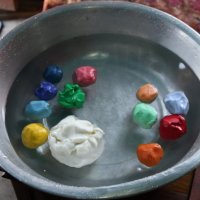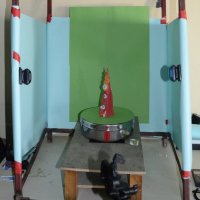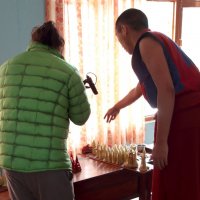In January 2015 two of the project members - Uwe Niebuhr and Kemi Tsewang - went for a three-week research trip to the Triten Norbutse Bon Monastery in Kathmandu, Nepal, for the art historical study and documentation of ephemeral religious art, in particular tormas.
The Triten Norbutse Institution (www.triten.org) has, since its founding by H.E. Yongdzin Lopön Tenzin Namdak Rinpoche in 1987, actively collaborated with western Tibetologists on the academic study of Bon traditions, and has therefore been one of the most important collaboration partners for us.
Our researchers were kindly invited by Ven. Khenpo Tenpa Yungdrung Rinpoche, the abbot of Triten Norbutse Monastery and our main collaborator, who is a practising teacher and lineage holder of the Bon religion. Our project members were, for the duration of the field research, kindly accommodated in the guest house by courtesy of the monastery.
Venerable Khenpo Rinpoche was kind enough to organize, in collaboration with Charles Ramble, a week-long torma workshop during which our project members received full support in their reserach endeavours by the monastery. Even a dedicated room was made available for our investigations and we would like to use this chance to express our heartfelt gratefulness to everybody at the Triten Norbutse monastery.
Preparations for the torma workshop were carried out with the support of Lama Tsultrim Sangjay. With his help the project members were able to get all the needed materials such as tsampa, color pigments, wax-butter etc. as well as tools, that had to be bought in markets spread all over the city of Kathmandu.
The labour intensive core of the torma-workshop lasted 5 days. Every day started with the production of dough and the colouring of butter.
13 monks divided into two main groups participated in the workshop. One group was engaged in the production of the torma-body and the other one worked on the elaborate butter decorations. The workshop was able to produce a total of 80 tormas spanning all main categories: yidam, protectors, and offering tormas.
The research team was equipped with two video cameras: one, mounted in a fixed position, was used to document the production process of the tormas; the second, handheld, for detail shots and to provide a general overview. Two SLR cameras where used to document the whole manufacturing process en detail. In additional audio recordings have been taken to document spoken commentaries. To provide a relatively consistent all-around view of each tormas an impromptu photo-booth with rotary table was set up and each torma was photographed from six angles. This process was carried out for each torma both without and with butter decoration. After having been photographed, the tormas were placed on the altar.
All information and measurements have been recorded in a data-sheet for each torma. Additionally, text sources and all tools were photographed. The construction of each tormas was detained in detail and sketches were made. Different interviews on the production process and on the biography of each monk were conducted.
The end of our workshop auspiciously coincided with Losar (Tibetan new year) which was celebrated during a 3 day long festivity consisting of different ceremonies like planting of trees, blessing ceremonies and the setting-up of prayer flags.














